Qantas Losing International Competitiveness
VerifiedAdded on 2023/04/20
|11
|2244
|480
AI Summary
This document discusses the challenges faced by Qantas Airways in maintaining its international competitiveness. It analyzes the competitive pressures and strategies employed by the company, with a focus on the impact of high costs and wages. The document also explores the role of digital systems in reducing costs for the company.
Contribute Materials
Your contribution can guide someone’s learning journey. Share your
documents today.
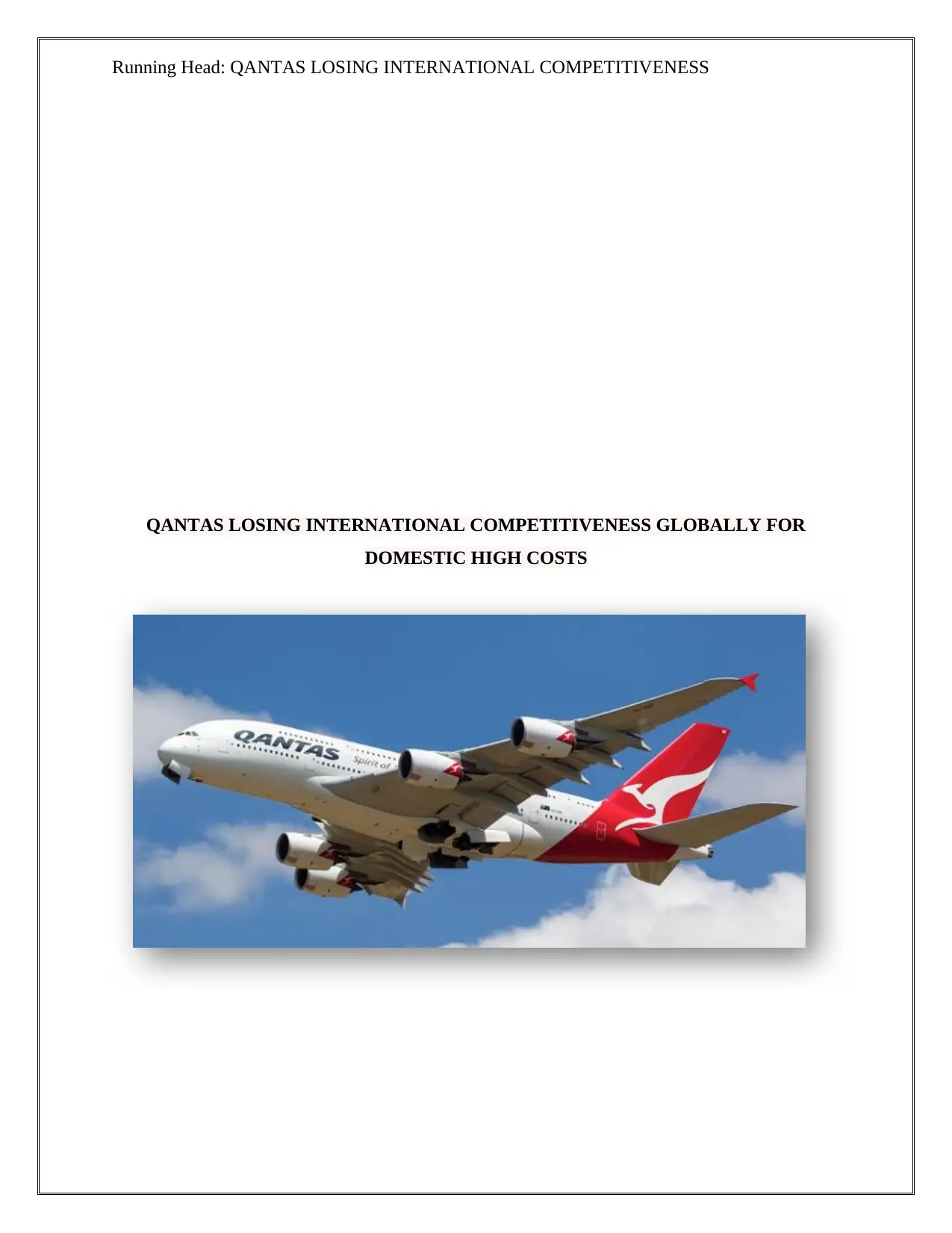
Running Head: QANTAS LOSING INTERNATIONAL COMPETITIVENESS
QANTAS LOSING INTERNATIONAL COMPETITIVENESS GLOBALLY FOR
DOMESTIC HIGH COSTS
QANTAS LOSING INTERNATIONAL COMPETITIVENESS GLOBALLY FOR
DOMESTIC HIGH COSTS
Secure Best Marks with AI Grader
Need help grading? Try our AI Grader for instant feedback on your assignments.
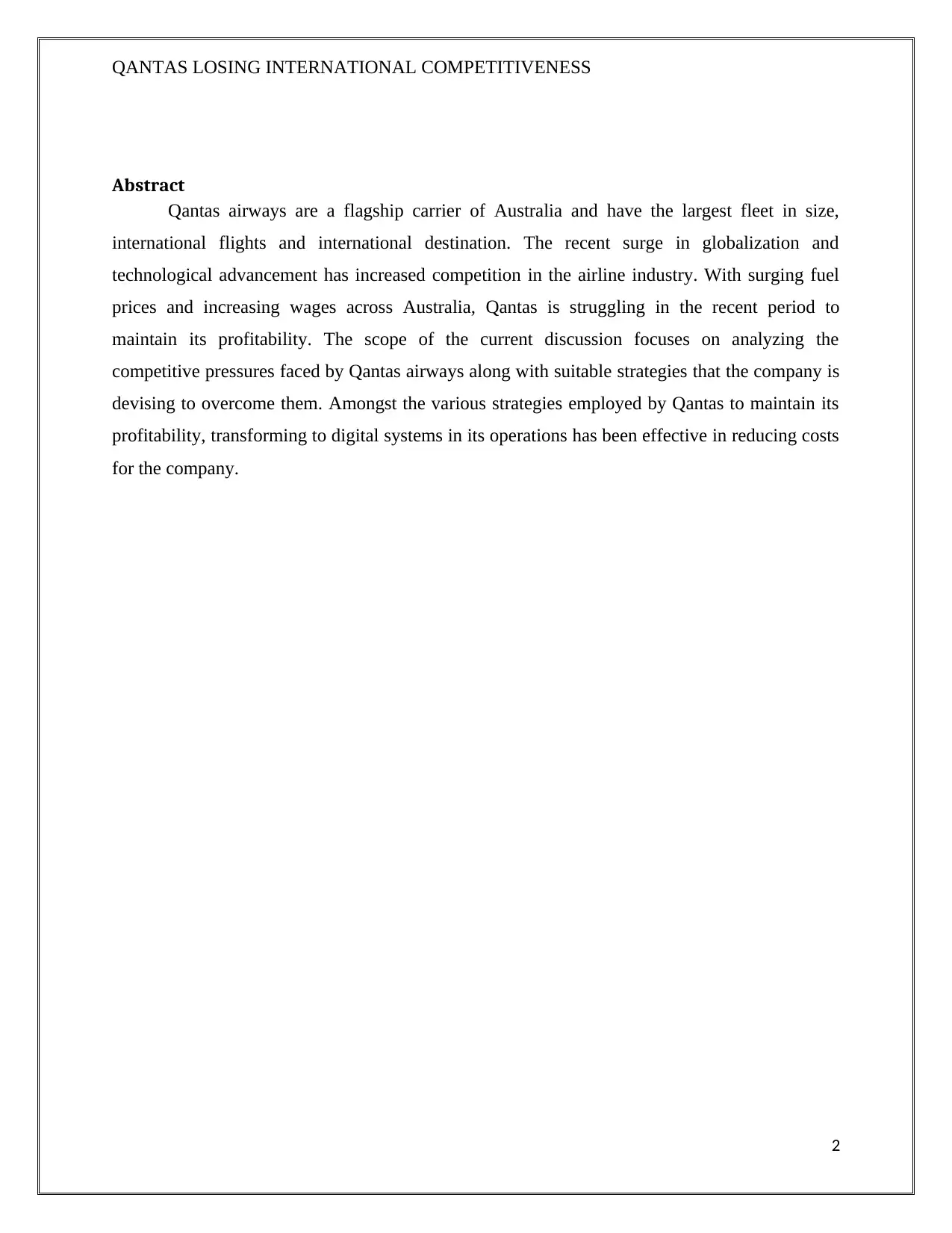
QANTAS LOSING INTERNATIONAL COMPETITIVENESS
Abstract
Qantas airways are a flagship carrier of Australia and have the largest fleet in size,
international flights and international destination. The recent surge in globalization and
technological advancement has increased competition in the airline industry. With surging fuel
prices and increasing wages across Australia, Qantas is struggling in the recent period to
maintain its profitability. The scope of the current discussion focuses on analyzing the
competitive pressures faced by Qantas airways along with suitable strategies that the company is
devising to overcome them. Amongst the various strategies employed by Qantas to maintain its
profitability, transforming to digital systems in its operations has been effective in reducing costs
for the company.
2
Abstract
Qantas airways are a flagship carrier of Australia and have the largest fleet in size,
international flights and international destination. The recent surge in globalization and
technological advancement has increased competition in the airline industry. With surging fuel
prices and increasing wages across Australia, Qantas is struggling in the recent period to
maintain its profitability. The scope of the current discussion focuses on analyzing the
competitive pressures faced by Qantas airways along with suitable strategies that the company is
devising to overcome them. Amongst the various strategies employed by Qantas to maintain its
profitability, transforming to digital systems in its operations has been effective in reducing costs
for the company.
2
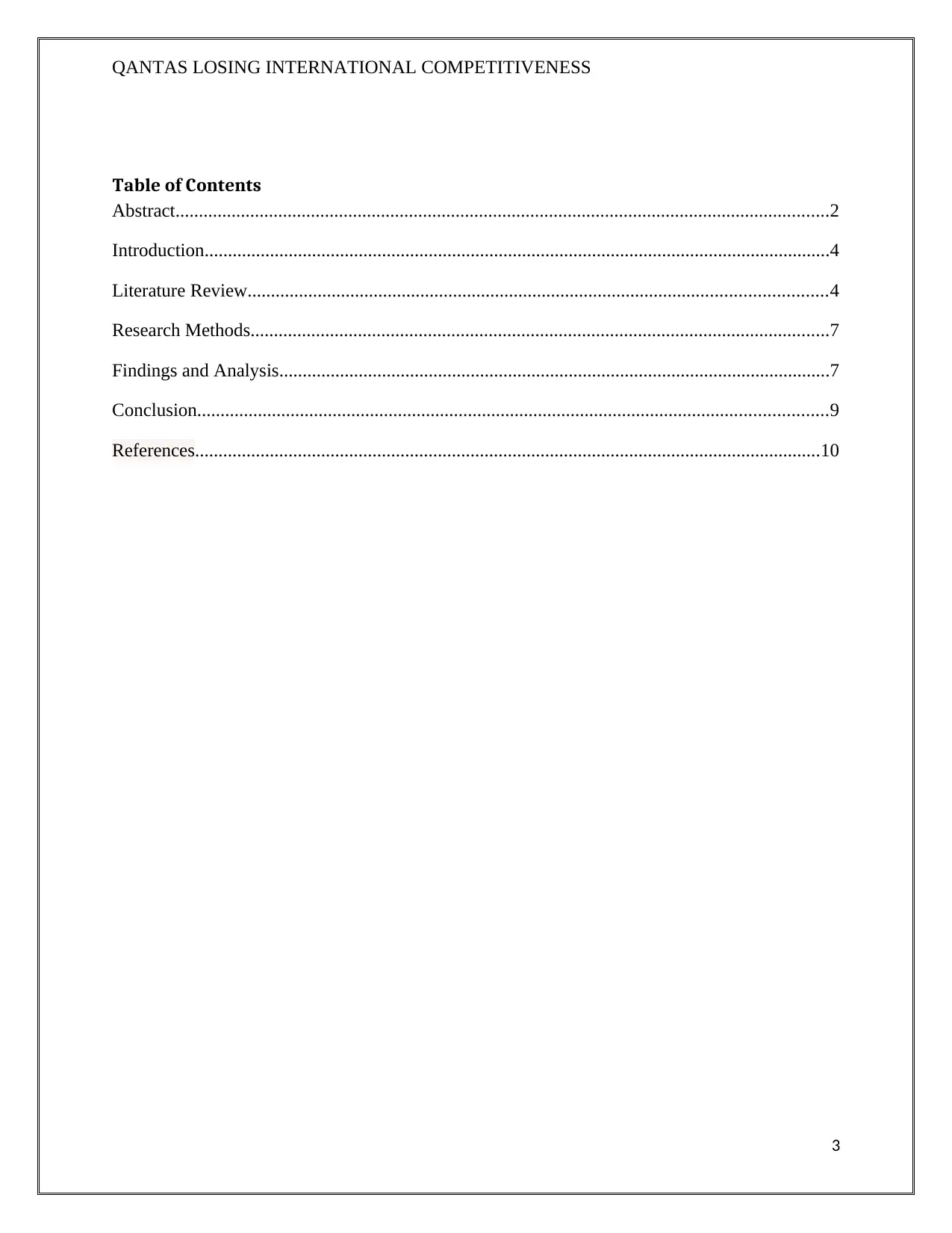
QANTAS LOSING INTERNATIONAL COMPETITIVENESS
Table of Contents
Abstract............................................................................................................................................2
Introduction......................................................................................................................................4
Literature Review............................................................................................................................4
Research Methods............................................................................................................................7
Findings and Analysis......................................................................................................................7
Conclusion.......................................................................................................................................9
References......................................................................................................................................10
3
Table of Contents
Abstract............................................................................................................................................2
Introduction......................................................................................................................................4
Literature Review............................................................................................................................4
Research Methods............................................................................................................................7
Findings and Analysis......................................................................................................................7
Conclusion.......................................................................................................................................9
References......................................................................................................................................10
3
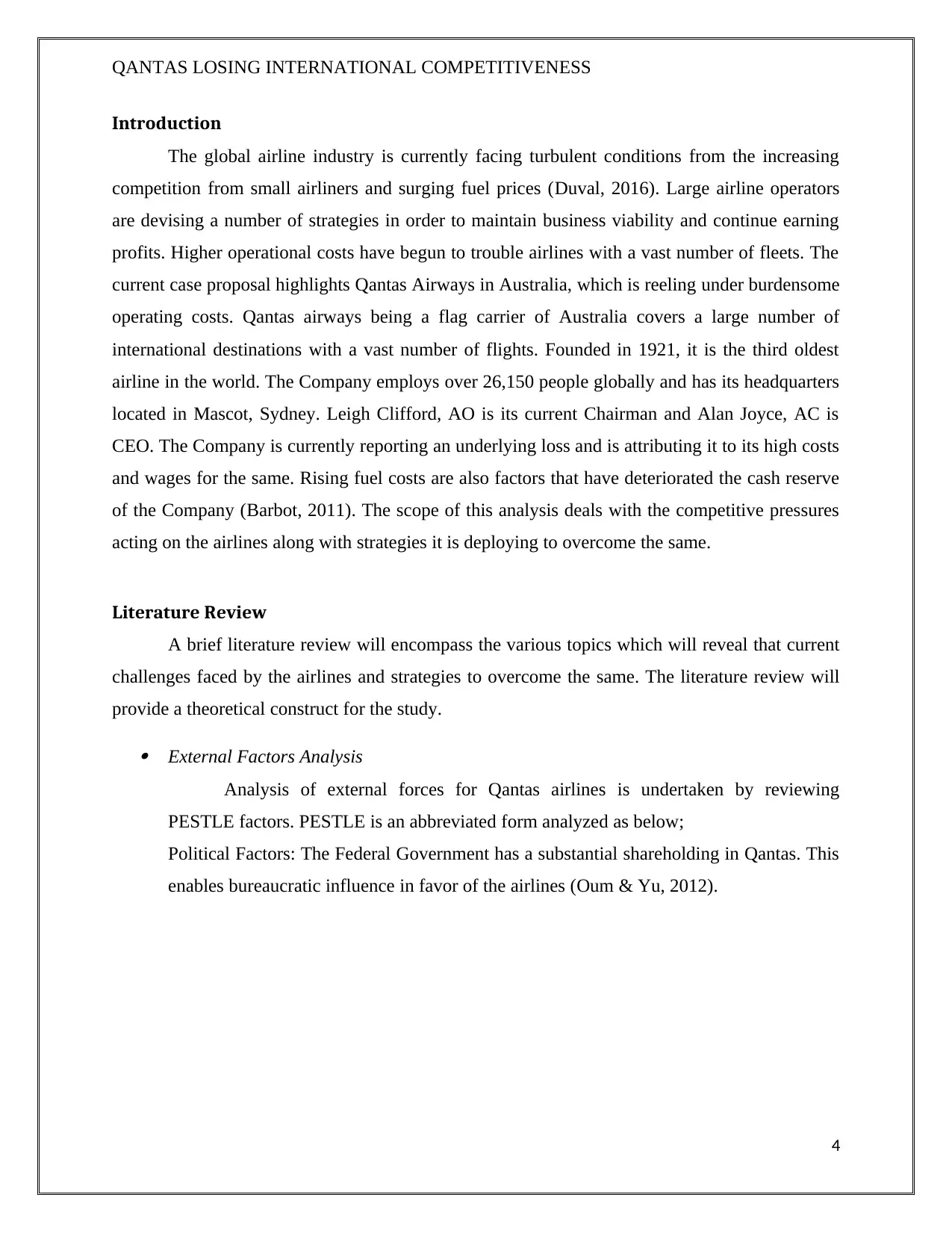
QANTAS LOSING INTERNATIONAL COMPETITIVENESS
Introduction
The global airline industry is currently facing turbulent conditions from the increasing
competition from small airliners and surging fuel prices (Duval, 2016). Large airline operators
are devising a number of strategies in order to maintain business viability and continue earning
profits. Higher operational costs have begun to trouble airlines with a vast number of fleets. The
current case proposal highlights Qantas Airways in Australia, which is reeling under burdensome
operating costs. Qantas airways being a flag carrier of Australia covers a large number of
international destinations with a vast number of flights. Founded in 1921, it is the third oldest
airline in the world. The Company employs over 26,150 people globally and has its headquarters
located in Mascot, Sydney. Leigh Clifford, AO is its current Chairman and Alan Joyce, AC is
CEO. The Company is currently reporting an underlying loss and is attributing it to its high costs
and wages for the same. Rising fuel costs are also factors that have deteriorated the cash reserve
of the Company (Barbot, 2011). The scope of this analysis deals with the competitive pressures
acting on the airlines along with strategies it is deploying to overcome the same.
Literature Review
A brief literature review will encompass the various topics which will reveal that current
challenges faced by the airlines and strategies to overcome the same. The literature review will
provide a theoretical construct for the study.
External Factors Analysis
Analysis of external forces for Qantas airlines is undertaken by reviewing
PESTLE factors. PESTLE is an abbreviated form analyzed as below;
Political Factors: The Federal Government has a substantial shareholding in Qantas. This
enables bureaucratic influence in favor of the airlines (Oum & Yu, 2012).
4
Introduction
The global airline industry is currently facing turbulent conditions from the increasing
competition from small airliners and surging fuel prices (Duval, 2016). Large airline operators
are devising a number of strategies in order to maintain business viability and continue earning
profits. Higher operational costs have begun to trouble airlines with a vast number of fleets. The
current case proposal highlights Qantas Airways in Australia, which is reeling under burdensome
operating costs. Qantas airways being a flag carrier of Australia covers a large number of
international destinations with a vast number of flights. Founded in 1921, it is the third oldest
airline in the world. The Company employs over 26,150 people globally and has its headquarters
located in Mascot, Sydney. Leigh Clifford, AO is its current Chairman and Alan Joyce, AC is
CEO. The Company is currently reporting an underlying loss and is attributing it to its high costs
and wages for the same. Rising fuel costs are also factors that have deteriorated the cash reserve
of the Company (Barbot, 2011). The scope of this analysis deals with the competitive pressures
acting on the airlines along with strategies it is deploying to overcome the same.
Literature Review
A brief literature review will encompass the various topics which will reveal that current
challenges faced by the airlines and strategies to overcome the same. The literature review will
provide a theoretical construct for the study.
External Factors Analysis
Analysis of external forces for Qantas airlines is undertaken by reviewing
PESTLE factors. PESTLE is an abbreviated form analyzed as below;
Political Factors: The Federal Government has a substantial shareholding in Qantas. This
enables bureaucratic influence in favor of the airlines (Oum & Yu, 2012).
4
Secure Best Marks with AI Grader
Need help grading? Try our AI Grader for instant feedback on your assignments.
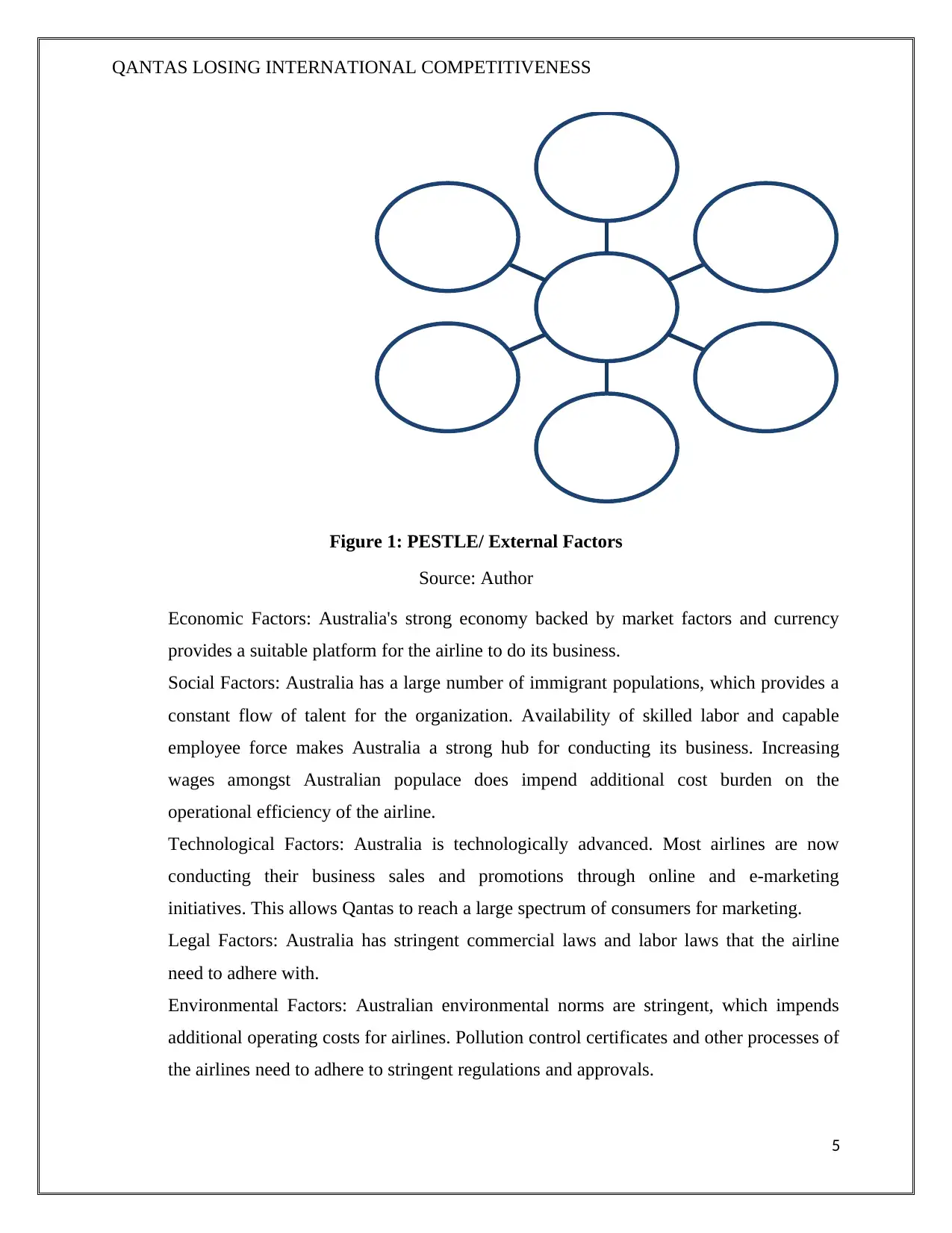
QANTAS LOSING INTERNATIONAL COMPETITIVENESS
Figure 1: PESTLE/ External Factors
Source: Author
Economic Factors: Australia's strong economy backed by market factors and currency
provides a suitable platform for the airline to do its business.
Social Factors: Australia has a large number of immigrant populations, which provides a
constant flow of talent for the organization. Availability of skilled labor and capable
employee force makes Australia a strong hub for conducting its business. Increasing
wages amongst Australian populace does impend additional cost burden on the
operational efficiency of the airline.
Technological Factors: Australia is technologically advanced. Most airlines are now
conducting their business sales and promotions through online and e-marketing
initiatives. This allows Qantas to reach a large spectrum of consumers for marketing.
Legal Factors: Australia has stringent commercial laws and labor laws that the airline
need to adhere with.
Environmental Factors: Australian environmental norms are stringent, which impends
additional operating costs for airlines. Pollution control certificates and other processes of
the airlines need to adhere to stringent regulations and approvals.
5
External
Factors
Political
Economic
Social
Technologi
cal
Legal
Environme
ntal
Figure 1: PESTLE/ External Factors
Source: Author
Economic Factors: Australia's strong economy backed by market factors and currency
provides a suitable platform for the airline to do its business.
Social Factors: Australia has a large number of immigrant populations, which provides a
constant flow of talent for the organization. Availability of skilled labor and capable
employee force makes Australia a strong hub for conducting its business. Increasing
wages amongst Australian populace does impend additional cost burden on the
operational efficiency of the airline.
Technological Factors: Australia is technologically advanced. Most airlines are now
conducting their business sales and promotions through online and e-marketing
initiatives. This allows Qantas to reach a large spectrum of consumers for marketing.
Legal Factors: Australia has stringent commercial laws and labor laws that the airline
need to adhere with.
Environmental Factors: Australian environmental norms are stringent, which impends
additional operating costs for airlines. Pollution control certificates and other processes of
the airlines need to adhere to stringent regulations and approvals.
5
External
Factors
Political
Economic
Social
Technologi
cal
Legal
Environme
ntal
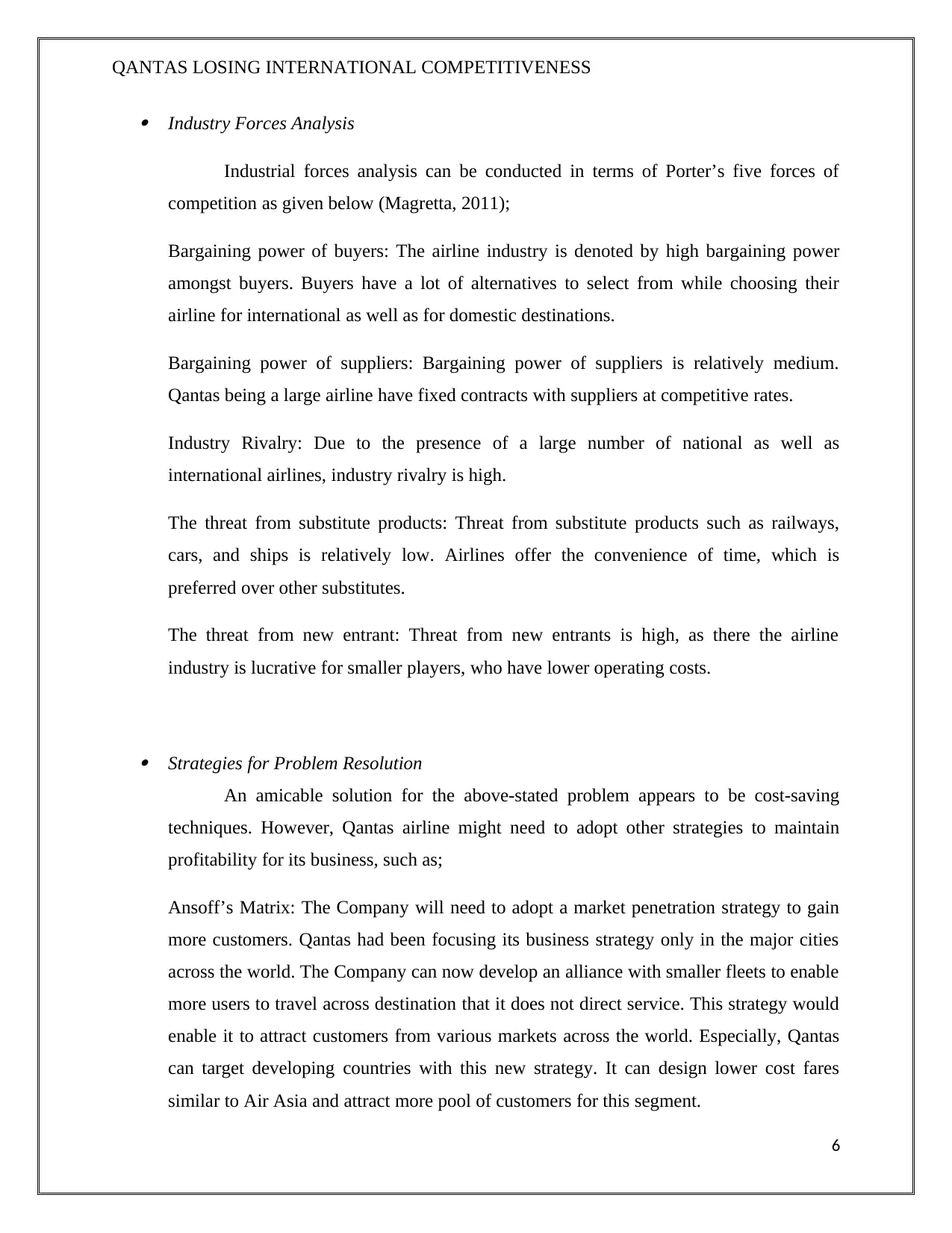
QANTAS LOSING INTERNATIONAL COMPETITIVENESS
Industry Forces Analysis
Industrial forces analysis can be conducted in terms of Porter’s five forces of
competition as given below (Magretta, 2011);
Bargaining power of buyers: The airline industry is denoted by high bargaining power
amongst buyers. Buyers have a lot of alternatives to select from while choosing their
airline for international as well as for domestic destinations.
Bargaining power of suppliers: Bargaining power of suppliers is relatively medium.
Qantas being a large airline have fixed contracts with suppliers at competitive rates.
Industry Rivalry: Due to the presence of a large number of national as well as
international airlines, industry rivalry is high.
The threat from substitute products: Threat from substitute products such as railways,
cars, and ships is relatively low. Airlines offer the convenience of time, which is
preferred over other substitutes.
The threat from new entrant: Threat from new entrants is high, as there the airline
industry is lucrative for smaller players, who have lower operating costs.
Strategies for Problem Resolution
An amicable solution for the above-stated problem appears to be cost-saving
techniques. However, Qantas airline might need to adopt other strategies to maintain
profitability for its business, such as;
Ansoff’s Matrix: The Company will need to adopt a market penetration strategy to gain
more customers. Qantas had been focusing its business strategy only in the major cities
across the world. The Company can now develop an alliance with smaller fleets to enable
more users to travel across destination that it does not direct service. This strategy would
enable it to attract customers from various markets across the world. Especially, Qantas
can target developing countries with this new strategy. It can design lower cost fares
similar to Air Asia and attract more pool of customers for this segment.
6
Industry Forces Analysis
Industrial forces analysis can be conducted in terms of Porter’s five forces of
competition as given below (Magretta, 2011);
Bargaining power of buyers: The airline industry is denoted by high bargaining power
amongst buyers. Buyers have a lot of alternatives to select from while choosing their
airline for international as well as for domestic destinations.
Bargaining power of suppliers: Bargaining power of suppliers is relatively medium.
Qantas being a large airline have fixed contracts with suppliers at competitive rates.
Industry Rivalry: Due to the presence of a large number of national as well as
international airlines, industry rivalry is high.
The threat from substitute products: Threat from substitute products such as railways,
cars, and ships is relatively low. Airlines offer the convenience of time, which is
preferred over other substitutes.
The threat from new entrant: Threat from new entrants is high, as there the airline
industry is lucrative for smaller players, who have lower operating costs.
Strategies for Problem Resolution
An amicable solution for the above-stated problem appears to be cost-saving
techniques. However, Qantas airline might need to adopt other strategies to maintain
profitability for its business, such as;
Ansoff’s Matrix: The Company will need to adopt a market penetration strategy to gain
more customers. Qantas had been focusing its business strategy only in the major cities
across the world. The Company can now develop an alliance with smaller fleets to enable
more users to travel across destination that it does not direct service. This strategy would
enable it to attract customers from various markets across the world. Especially, Qantas
can target developing countries with this new strategy. It can design lower cost fares
similar to Air Asia and attract more pool of customers for this segment.
6
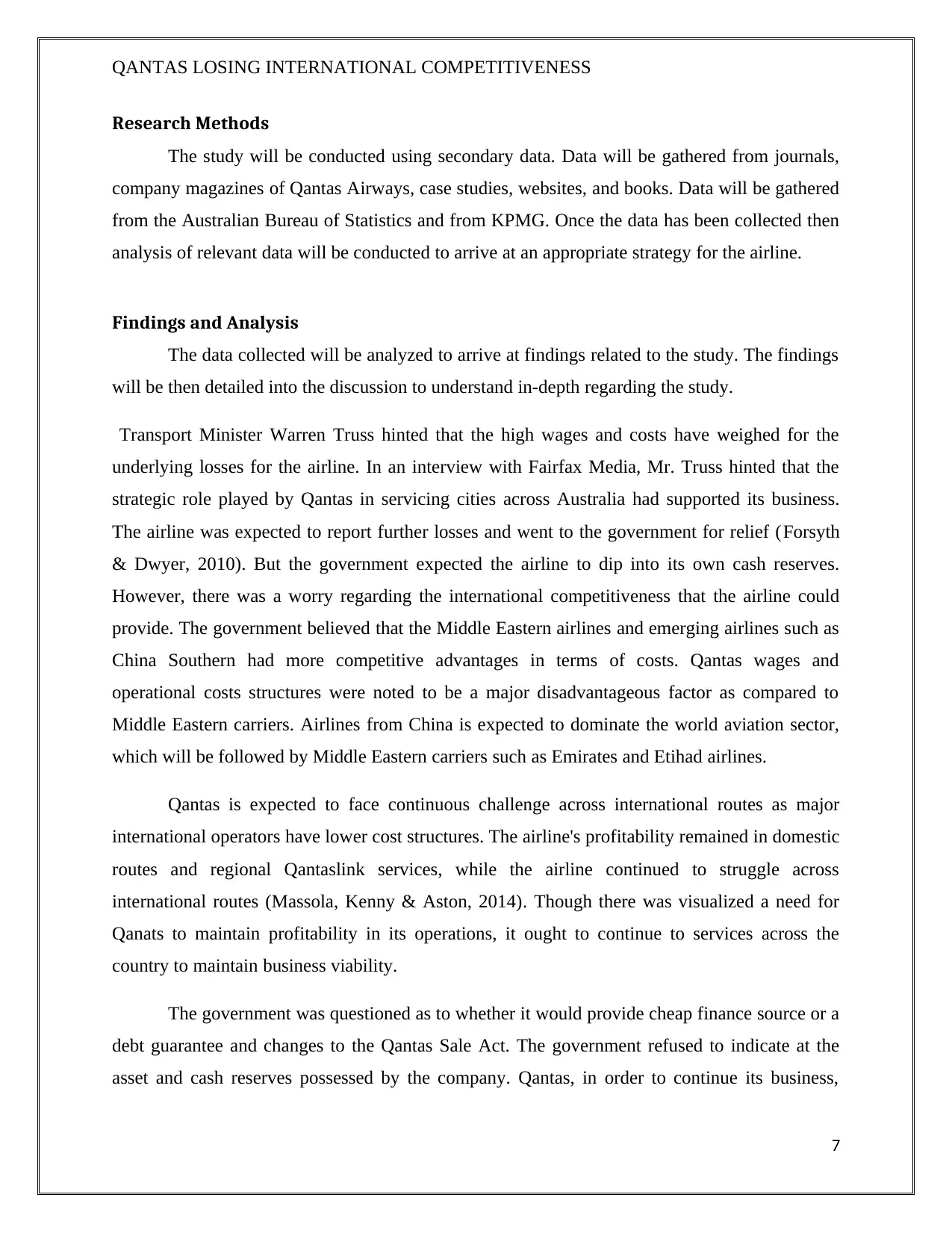
QANTAS LOSING INTERNATIONAL COMPETITIVENESS
Research Methods
The study will be conducted using secondary data. Data will be gathered from journals,
company magazines of Qantas Airways, case studies, websites, and books. Data will be gathered
from the Australian Bureau of Statistics and from KPMG. Once the data has been collected then
analysis of relevant data will be conducted to arrive at an appropriate strategy for the airline.
Findings and Analysis
The data collected will be analyzed to arrive at findings related to the study. The findings
will be then detailed into the discussion to understand in-depth regarding the study.
Transport Minister Warren Truss hinted that the high wages and costs have weighed for the
underlying losses for the airline. In an interview with Fairfax Media, Mr. Truss hinted that the
strategic role played by Qantas in servicing cities across Australia had supported its business.
The airline was expected to report further losses and went to the government for relief (Forsyth
& Dwyer, 2010). But the government expected the airline to dip into its own cash reserves.
However, there was a worry regarding the international competitiveness that the airline could
provide. The government believed that the Middle Eastern airlines and emerging airlines such as
China Southern had more competitive advantages in terms of costs. Qantas wages and
operational costs structures were noted to be a major disadvantageous factor as compared to
Middle Eastern carriers. Airlines from China is expected to dominate the world aviation sector,
which will be followed by Middle Eastern carriers such as Emirates and Etihad airlines.
Qantas is expected to face continuous challenge across international routes as major
international operators have lower cost structures. The airline's profitability remained in domestic
routes and regional Qantaslink services, while the airline continued to struggle across
international routes (Massola, Kenny & Aston, 2014). Though there was visualized a need for
Qanats to maintain profitability in its operations, it ought to continue to services across the
country to maintain business viability.
The government was questioned as to whether it would provide cheap finance source or a
debt guarantee and changes to the Qantas Sale Act. The government refused to indicate at the
asset and cash reserves possessed by the company. Qantas, in order to continue its business,
7
Research Methods
The study will be conducted using secondary data. Data will be gathered from journals,
company magazines of Qantas Airways, case studies, websites, and books. Data will be gathered
from the Australian Bureau of Statistics and from KPMG. Once the data has been collected then
analysis of relevant data will be conducted to arrive at an appropriate strategy for the airline.
Findings and Analysis
The data collected will be analyzed to arrive at findings related to the study. The findings
will be then detailed into the discussion to understand in-depth regarding the study.
Transport Minister Warren Truss hinted that the high wages and costs have weighed for the
underlying losses for the airline. In an interview with Fairfax Media, Mr. Truss hinted that the
strategic role played by Qantas in servicing cities across Australia had supported its business.
The airline was expected to report further losses and went to the government for relief (Forsyth
& Dwyer, 2010). But the government expected the airline to dip into its own cash reserves.
However, there was a worry regarding the international competitiveness that the airline could
provide. The government believed that the Middle Eastern airlines and emerging airlines such as
China Southern had more competitive advantages in terms of costs. Qantas wages and
operational costs structures were noted to be a major disadvantageous factor as compared to
Middle Eastern carriers. Airlines from China is expected to dominate the world aviation sector,
which will be followed by Middle Eastern carriers such as Emirates and Etihad airlines.
Qantas is expected to face continuous challenge across international routes as major
international operators have lower cost structures. The airline's profitability remained in domestic
routes and regional Qantaslink services, while the airline continued to struggle across
international routes (Massola, Kenny & Aston, 2014). Though there was visualized a need for
Qanats to maintain profitability in its operations, it ought to continue to services across the
country to maintain business viability.
The government was questioned as to whether it would provide cheap finance source or a
debt guarantee and changes to the Qantas Sale Act. The government refused to indicate at the
asset and cash reserves possessed by the company. Qantas, in order to continue its business,
7
Paraphrase This Document
Need a fresh take? Get an instant paraphrase of this document with our AI Paraphraser
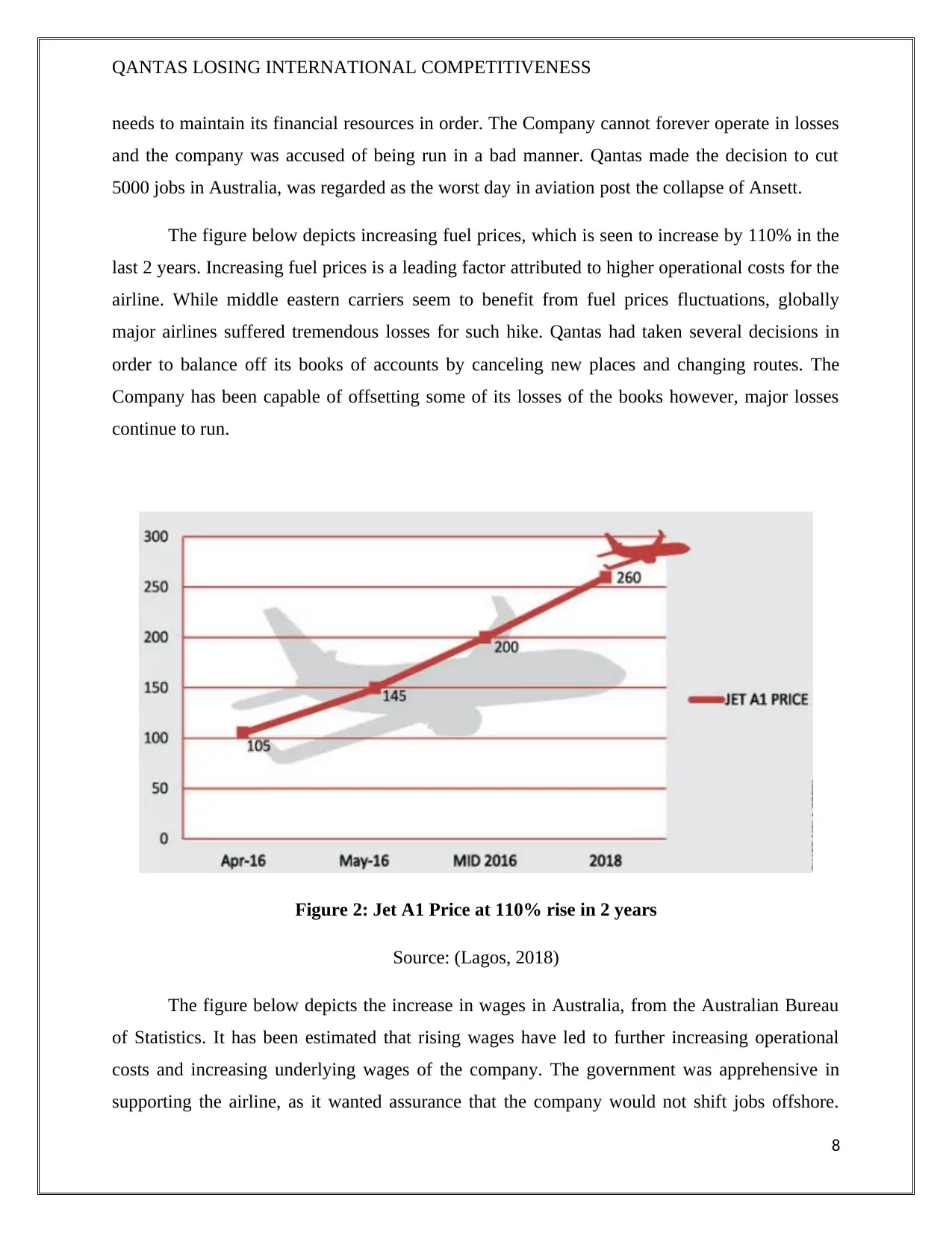
QANTAS LOSING INTERNATIONAL COMPETITIVENESS
needs to maintain its financial resources in order. The Company cannot forever operate in losses
and the company was accused of being run in a bad manner. Qantas made the decision to cut
5000 jobs in Australia, was regarded as the worst day in aviation post the collapse of Ansett.
The figure below depicts increasing fuel prices, which is seen to increase by 110% in the
last 2 years. Increasing fuel prices is a leading factor attributed to higher operational costs for the
airline. While middle eastern carriers seem to benefit from fuel prices fluctuations, globally
major airlines suffered tremendous losses for such hike. Qantas had taken several decisions in
order to balance off its books of accounts by canceling new places and changing routes. The
Company has been capable of offsetting some of its losses of the books however, major losses
continue to run.
Figure 2: Jet A1 Price at 110% rise in 2 years
Source: (Lagos, 2018)
The figure below depicts the increase in wages in Australia, from the Australian Bureau
of Statistics. It has been estimated that rising wages have led to further increasing operational
costs and increasing underlying wages of the company. The government was apprehensive in
supporting the airline, as it wanted assurance that the company would not shift jobs offshore.
8
needs to maintain its financial resources in order. The Company cannot forever operate in losses
and the company was accused of being run in a bad manner. Qantas made the decision to cut
5000 jobs in Australia, was regarded as the worst day in aviation post the collapse of Ansett.
The figure below depicts increasing fuel prices, which is seen to increase by 110% in the
last 2 years. Increasing fuel prices is a leading factor attributed to higher operational costs for the
airline. While middle eastern carriers seem to benefit from fuel prices fluctuations, globally
major airlines suffered tremendous losses for such hike. Qantas had taken several decisions in
order to balance off its books of accounts by canceling new places and changing routes. The
Company has been capable of offsetting some of its losses of the books however, major losses
continue to run.
Figure 2: Jet A1 Price at 110% rise in 2 years
Source: (Lagos, 2018)
The figure below depicts the increase in wages in Australia, from the Australian Bureau
of Statistics. It has been estimated that rising wages have led to further increasing operational
costs and increasing underlying wages of the company. The government was apprehensive in
supporting the airline, as it wanted assurance that the company would not shift jobs offshore.
8
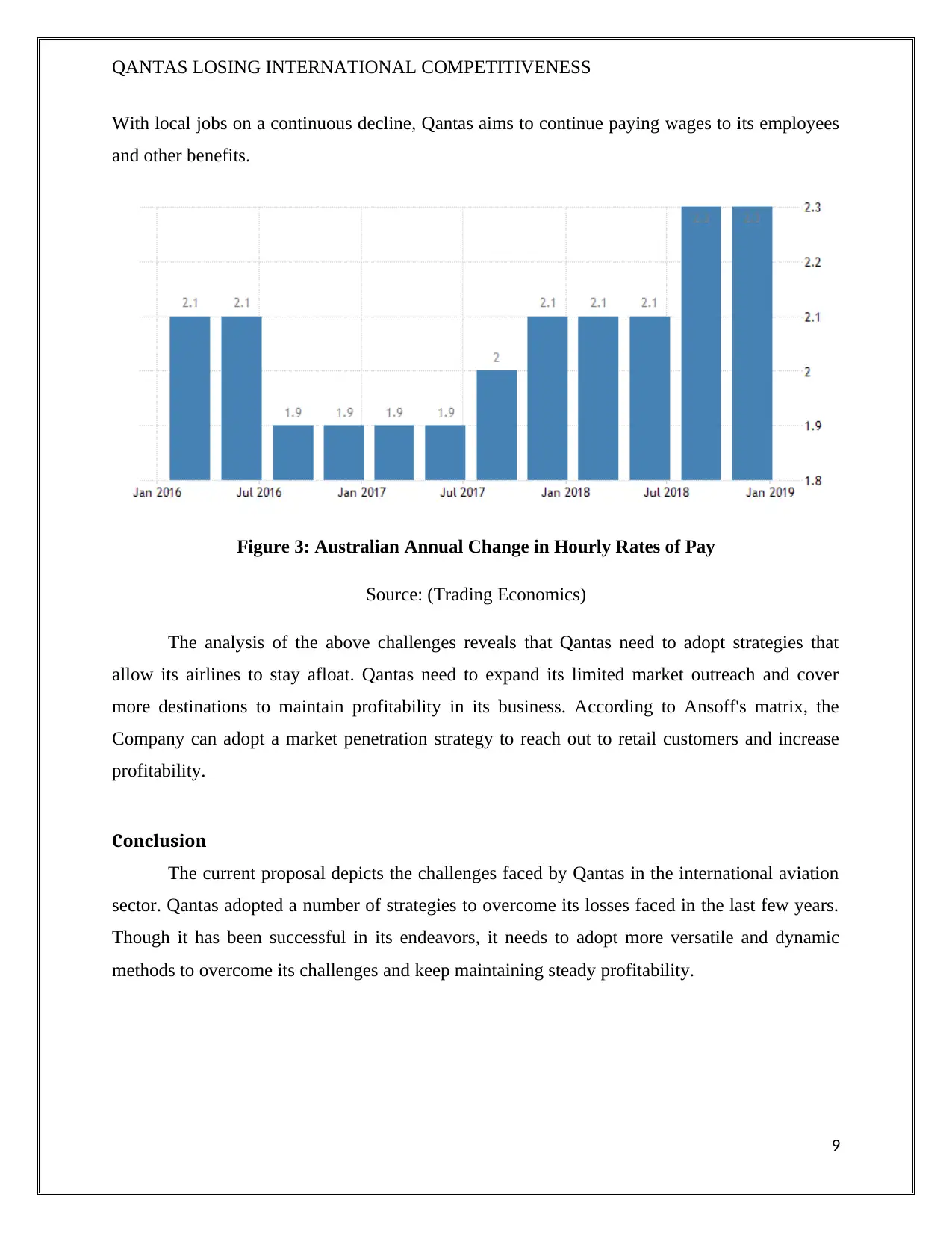
QANTAS LOSING INTERNATIONAL COMPETITIVENESS
With local jobs on a continuous decline, Qantas aims to continue paying wages to its employees
and other benefits.
Figure 3: Australian Annual Change in Hourly Rates of Pay
Source: (Trading Economics)
The analysis of the above challenges reveals that Qantas need to adopt strategies that
allow its airlines to stay afloat. Qantas need to expand its limited market outreach and cover
more destinations to maintain profitability in its business. According to Ansoff's matrix, the
Company can adopt a market penetration strategy to reach out to retail customers and increase
profitability.
Conclusion
The current proposal depicts the challenges faced by Qantas in the international aviation
sector. Qantas adopted a number of strategies to overcome its losses faced in the last few years.
Though it has been successful in its endeavors, it needs to adopt more versatile and dynamic
methods to overcome its challenges and keep maintaining steady profitability.
9
With local jobs on a continuous decline, Qantas aims to continue paying wages to its employees
and other benefits.
Figure 3: Australian Annual Change in Hourly Rates of Pay
Source: (Trading Economics)
The analysis of the above challenges reveals that Qantas need to adopt strategies that
allow its airlines to stay afloat. Qantas need to expand its limited market outreach and cover
more destinations to maintain profitability in its business. According to Ansoff's matrix, the
Company can adopt a market penetration strategy to reach out to retail customers and increase
profitability.
Conclusion
The current proposal depicts the challenges faced by Qantas in the international aviation
sector. Qantas adopted a number of strategies to overcome its losses faced in the last few years.
Though it has been successful in its endeavors, it needs to adopt more versatile and dynamic
methods to overcome its challenges and keep maintaining steady profitability.
9
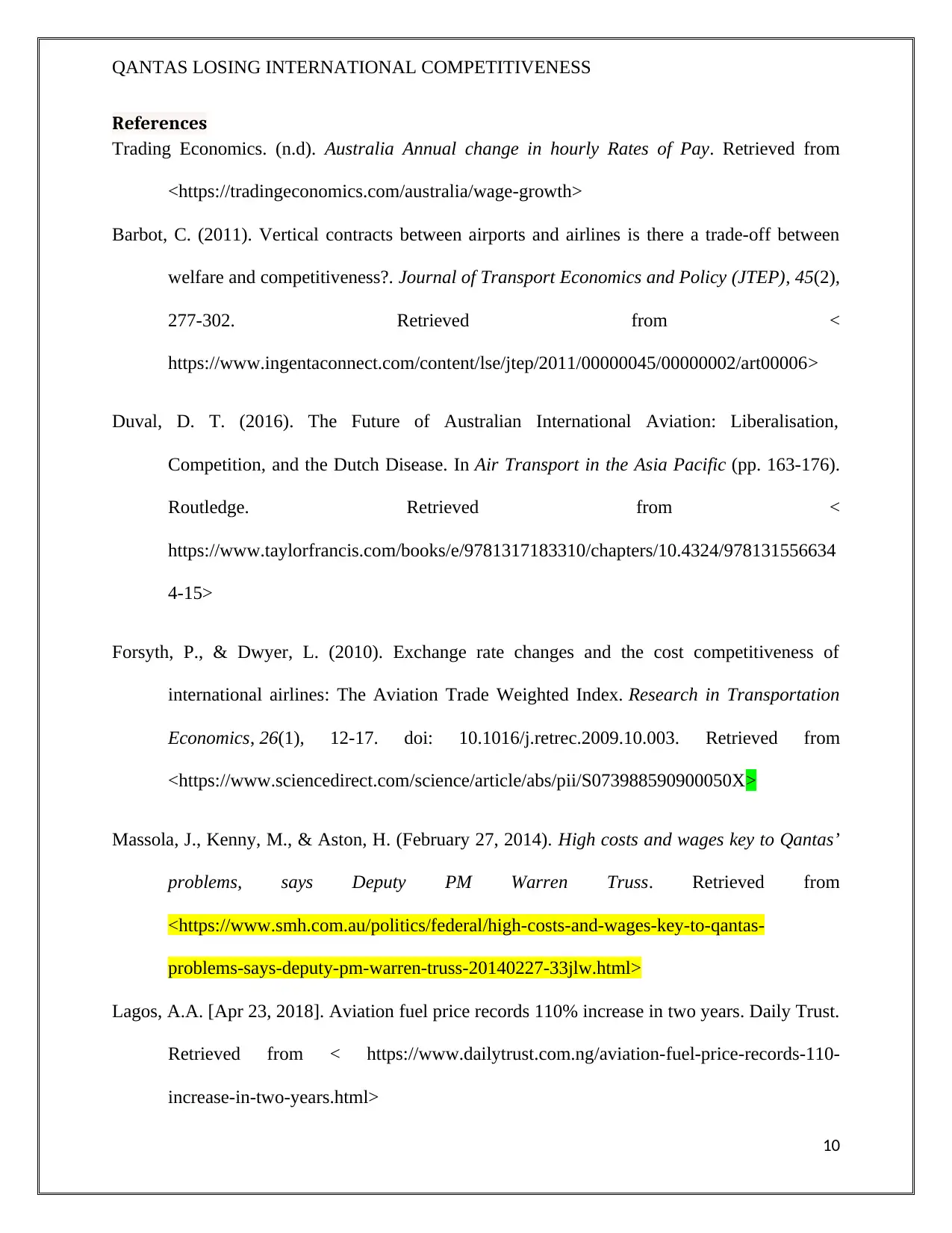
QANTAS LOSING INTERNATIONAL COMPETITIVENESS
References
Trading Economics. (n.d). Australia Annual change in hourly Rates of Pay. Retrieved from
<https://tradingeconomics.com/australia/wage-growth>
Barbot, C. (2011). Vertical contracts between airports and airlines is there a trade-off between
welfare and competitiveness?. Journal of Transport Economics and Policy (JTEP), 45(2),
277-302. Retrieved from <
https://www.ingentaconnect.com/content/lse/jtep/2011/00000045/00000002/art00006>
Duval, D. T. (2016). The Future of Australian International Aviation: Liberalisation,
Competition, and the Dutch Disease. In Air Transport in the Asia Pacific (pp. 163-176).
Routledge. Retrieved from <
https://www.taylorfrancis.com/books/e/9781317183310/chapters/10.4324/978131556634
4-15>
Forsyth, P., & Dwyer, L. (2010). Exchange rate changes and the cost competitiveness of
international airlines: The Aviation Trade Weighted Index. Research in Transportation
Economics, 26(1), 12-17. doi: 10.1016/j.retrec.2009.10.003. Retrieved from
<https://www.sciencedirect.com/science/article/abs/pii/S073988590900050X>
Massola, J., Kenny, M., & Aston, H. (February 27, 2014). High costs and wages key to Qantas’
problems, says Deputy PM Warren Truss. Retrieved from
<https://www.smh.com.au/politics/federal/high-costs-and-wages-key-to-qantas-
problems-says-deputy-pm-warren-truss-20140227-33jlw.html>
Lagos, A.A. [Apr 23, 2018]. Aviation fuel price records 110% increase in two years. Daily Trust.
Retrieved from < https://www.dailytrust.com.ng/aviation-fuel-price-records-110-
increase-in-two-years.html>
10
References
Trading Economics. (n.d). Australia Annual change in hourly Rates of Pay. Retrieved from
<https://tradingeconomics.com/australia/wage-growth>
Barbot, C. (2011). Vertical contracts between airports and airlines is there a trade-off between
welfare and competitiveness?. Journal of Transport Economics and Policy (JTEP), 45(2),
277-302. Retrieved from <
https://www.ingentaconnect.com/content/lse/jtep/2011/00000045/00000002/art00006>
Duval, D. T. (2016). The Future of Australian International Aviation: Liberalisation,
Competition, and the Dutch Disease. In Air Transport in the Asia Pacific (pp. 163-176).
Routledge. Retrieved from <
https://www.taylorfrancis.com/books/e/9781317183310/chapters/10.4324/978131556634
4-15>
Forsyth, P., & Dwyer, L. (2010). Exchange rate changes and the cost competitiveness of
international airlines: The Aviation Trade Weighted Index. Research in Transportation
Economics, 26(1), 12-17. doi: 10.1016/j.retrec.2009.10.003. Retrieved from
<https://www.sciencedirect.com/science/article/abs/pii/S073988590900050X>
Massola, J., Kenny, M., & Aston, H. (February 27, 2014). High costs and wages key to Qantas’
problems, says Deputy PM Warren Truss. Retrieved from
<https://www.smh.com.au/politics/federal/high-costs-and-wages-key-to-qantas-
problems-says-deputy-pm-warren-truss-20140227-33jlw.html>
Lagos, A.A. [Apr 23, 2018]. Aviation fuel price records 110% increase in two years. Daily Trust.
Retrieved from < https://www.dailytrust.com.ng/aviation-fuel-price-records-110-
increase-in-two-years.html>
10
Secure Best Marks with AI Grader
Need help grading? Try our AI Grader for instant feedback on your assignments.
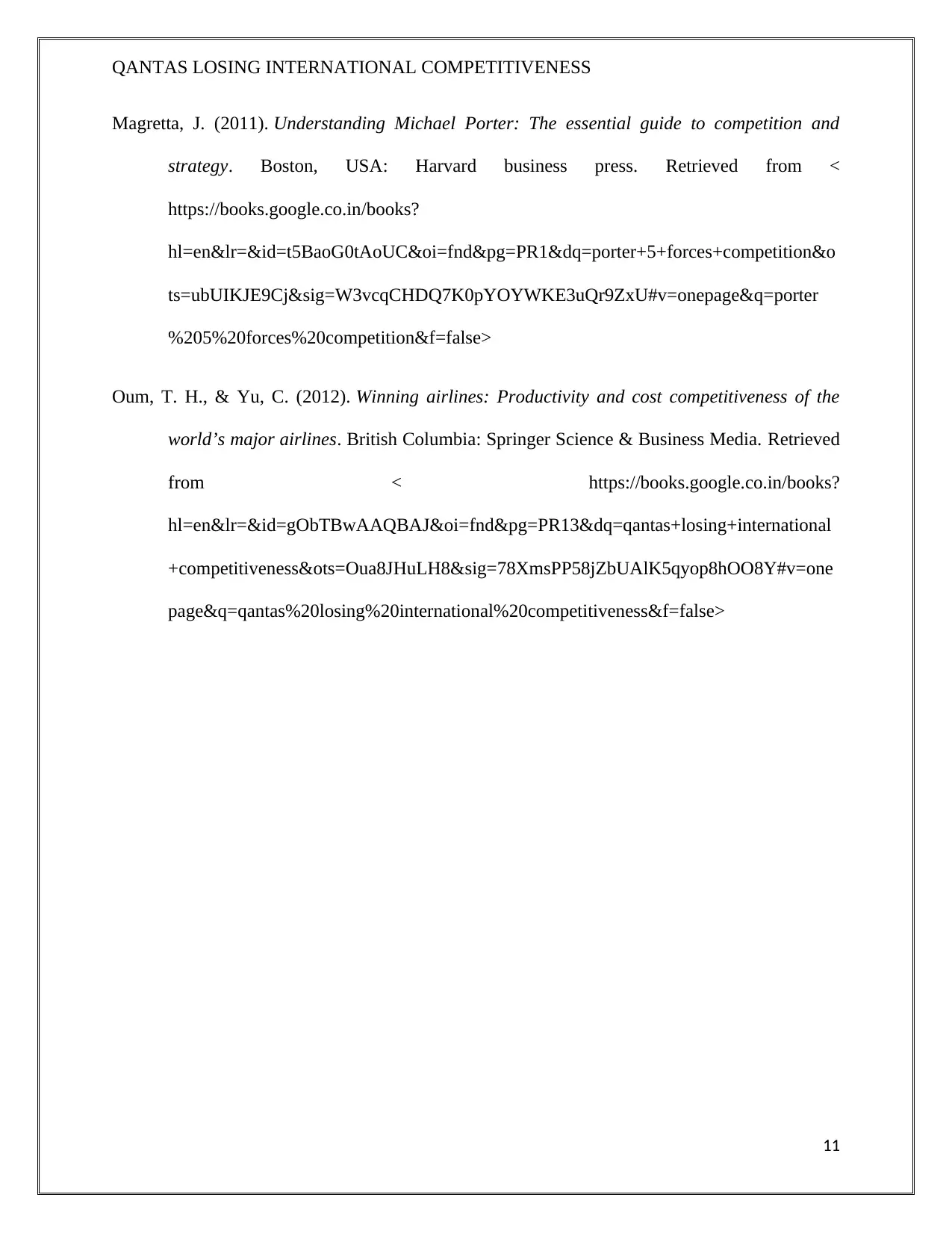
QANTAS LOSING INTERNATIONAL COMPETITIVENESS
Magretta, J. (2011). Understanding Michael Porter: The essential guide to competition and
strategy. Boston, USA: Harvard business press. Retrieved from <
https://books.google.co.in/books?
hl=en&lr=&id=t5BaoG0tAoUC&oi=fnd&pg=PR1&dq=porter+5+forces+competition&o
ts=ubUIKJE9Cj&sig=W3vcqCHDQ7K0pYOYWKE3uQr9ZxU#v=onepage&q=porter
%205%20forces%20competition&f=false>
Oum, T. H., & Yu, C. (2012). Winning airlines: Productivity and cost competitiveness of the
world’s major airlines. British Columbia: Springer Science & Business Media. Retrieved
from < https://books.google.co.in/books?
hl=en&lr=&id=gObTBwAAQBAJ&oi=fnd&pg=PR13&dq=qantas+losing+international
+competitiveness&ots=Oua8JHuLH8&sig=78XmsPP58jZbUAlK5qyop8hOO8Y#v=one
page&q=qantas%20losing%20international%20competitiveness&f=false>
11
Magretta, J. (2011). Understanding Michael Porter: The essential guide to competition and
strategy. Boston, USA: Harvard business press. Retrieved from <
https://books.google.co.in/books?
hl=en&lr=&id=t5BaoG0tAoUC&oi=fnd&pg=PR1&dq=porter+5+forces+competition&o
ts=ubUIKJE9Cj&sig=W3vcqCHDQ7K0pYOYWKE3uQr9ZxU#v=onepage&q=porter
%205%20forces%20competition&f=false>
Oum, T. H., & Yu, C. (2012). Winning airlines: Productivity and cost competitiveness of the
world’s major airlines. British Columbia: Springer Science & Business Media. Retrieved
from < https://books.google.co.in/books?
hl=en&lr=&id=gObTBwAAQBAJ&oi=fnd&pg=PR13&dq=qantas+losing+international
+competitiveness&ots=Oua8JHuLH8&sig=78XmsPP58jZbUAlK5qyop8hOO8Y#v=one
page&q=qantas%20losing%20international%20competitiveness&f=false>
11
1 out of 11
Related Documents
Your All-in-One AI-Powered Toolkit for Academic Success.
+13062052269
info@desklib.com
Available 24*7 on WhatsApp / Email
![[object Object]](/_next/static/media/star-bottom.7253800d.svg)
Unlock your academic potential
© 2024 | Zucol Services PVT LTD | All rights reserved.





